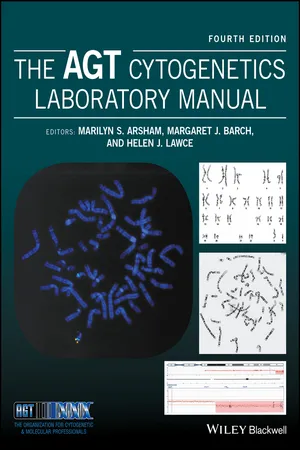
The AGT Cytogenetics Laboratory Manual
- English
- ePUB (mobile friendly)
- Available on iOS & Android
The AGT Cytogenetics Laboratory Manual
About this book
Cytogenetics is the study of chromosome morphology, structure, pathology, function, and behavior. The field has evolved to embrace molecular cytogenetic changes, now termed cytogenomics.
Cytogeneticists utilize an assortment of procedures to investigate the full complement of chromosomes and/or a targeted region within a specific chromosome in metaphase or interphase. Tools include routine analysis of G-banded chromosomes, specialized stains that address specific chromosomal structures, and molecular probes, such as fluorescence in situ hybridization (FISH) and chromosome microarray analysis, which employ a variety of methods to highlight a region as small as a single, specific genetic sequence under investigation.
The AGT Cytogenetics Laboratory Manual, Fourth Edition offers a comprehensive description of the diagnostic tests offered by the clinical laboratory and explains the science behind them. One of the most valuable assets is its rich compilation of laboratory-tested protocols currently being used in leading laboratories, along with practical advice for nearly every area of interest to cytogeneticists. In addition to covering essential topics that have been the backbone of cytogenetics for over 60 years, such as the basic components of a cell, use of a microscope, human tissue processing for cytogenetic analysis (prenatal, constitutional, and neoplastic), laboratory safety, and the mechanisms behind chromosome rearrangement and aneuploidy, this edition introduces new and expanded chapters by experts in the field. Some of these new topics include a unique collection of chromosome heteromorphisms; clinical examples of genomic imprinting; an example-driven overview of chromosomal microarray; mathematics specifically geared for the cytogeneticist; usage of ISCN's cytogenetic language to describe chromosome changes; tips for laboratory management; examples of laboratory information systems; a collection of internet and library resources; and a special chapter on animal chromosomes for the research and zoo cytogeneticist. The range of topics is thus broad yet comprehensive, offering the student a resource that teaches the procedures performed in the cytogenetics laboratory environment, and the laboratory professional with a peer-reviewed reference that explores the basis of each of these procedures. This makes it a useful resource for researchers, clinicians, and lab professionals, as well as students in a university or medical school setting.
Frequently asked questions
- Essential is ideal for learners and professionals who enjoy exploring a wide range of subjects. Access the Essential Library with 800,000+ trusted titles and best-sellers across business, personal growth, and the humanities. Includes unlimited reading time and Standard Read Aloud voice.
- Complete: Perfect for advanced learners and researchers needing full, unrestricted access. Unlock 1.4M+ books across hundreds of subjects, including academic and specialized titles. The Complete Plan also includes advanced features like Premium Read Aloud and Research Assistant.
Please note we cannot support devices running on iOS 13 and Android 7 or earlier. Learn more about using the app.
Information
CHAPTER 1
The cell and cell division
1.1 The cell [1,2]
1.1.1 Cell membrane
Composition

Physical barrier
Regulatory barrier
Glycoprotein functionality
1.1.2 Cytoplasm
Proteins
Polysaccharides
Lipids
Endoplasmic reticulum
Table of contents
- Cover
- Title Page
- Table of Contents
- Contributing authors
- Preface
- Acknowledgments
- CHAPTER 1: The cell and cell division
- CHAPTER 2: Cytogenetics: an overview
- CHAPTER 3: Peripheral blood cytogenetic methods
- CHAPTER 4: General cell culture principles and fibroblast culture
- CHAPTER 5: Prenatal chromosome diagnosis
- CHAPTER 6: Chromosome stains
- CHAPTER 7: Human chromosomes: identification and variations
- CHAPTER 8: ISCN: the universal language of cytogenetics
- CHAPTER 9: Constitutional chromosome abnormalities
- CHAPTER 10: Genomic imprinting
- CHAPTER 11: Cytogenetic analysis of hematologic malignant diseases
- CHAPTER 12: Cytogenetic methods and findings in human solid tumors
- CHAPTER 13: Chromosome instability syndromes
- CHAPTER 14: Microscopy and imaging
- CHAPTER 15: Computer imaging
- CHAPTER 16: Fluorescence in situ hybridization (FISH)
- CHAPTER 17: Multicolor FISH (SKY and M-FISH) and CGH
- CHAPTER 18: Genomic microarray technologies for the cytogenetics laboratory
- CHAPTER 19: Mathematics for the cytogenetic technologist
- CHAPTER 20: Selected topics on safety, equipment maintenance, and compliance for the cytogenetics laboratory
- CHAPTER 21: A system approach to quality
- CHAPTER 22: Laboratory management
- CHAPTER 23: Laboratory information system
- CHAPTER 24: Animal cytogenetics
- CHAPTER 25: Online genetic resources and references
- Index
- End User License Agreement